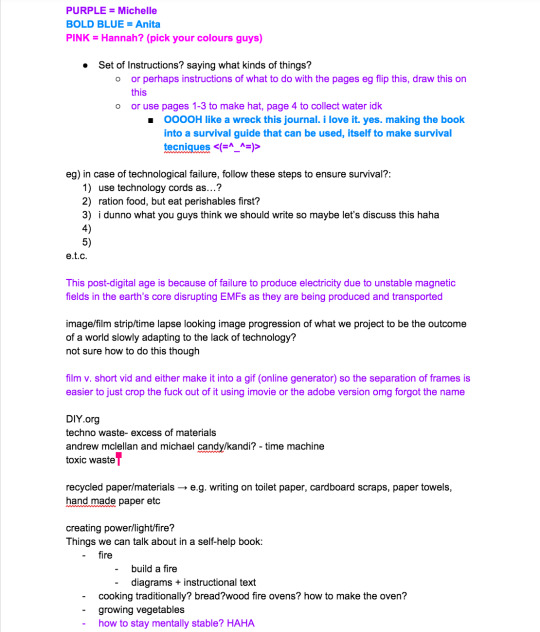Michelle Huang, Bachelor of Commerce and Bachelor of Fine Arts Student @ UNSW
Don't wanna be here? Send us removal request.
Photo

Experimentation
Playing with sewing with copper wire that I found in dad’s toolbox.
0 notes
Text
Resources for assessment 3
How to make recycled paper http://www.wikihow.com/Make-Paper
Rodrigo Alonso’s ‘New: No More Electronic Waste’ → using e-waste to create art inspiration http://inhabitat.com/rodrigo-alonsos-new-seats-turn-e-waste-into-a-cool-electronic-time-capsules/
Two Articles discussing the success and reason for reading self help books: http://www.mindbodygreen.com/0-15734/5-reasons-to-read-self-help-books-even-if-you-think-you-dont-need-to.html https://www.quora.com/Why-Do-99-of-People-Who-Read-Self-Help-Books-Fail-To-Get-Results
Information on Andrew Mclellan: http://www.liquidarchitecture.org.au/program/andrew-mclellan/
E-Waste Projects and Artworks: http://www.betterworldsolutions.eu/e-waste-as-art/
Safety measures for working with techno waste: http://thecreatorsproject.vice.com/blog/8-projects-turning-deadly-e-waste-into-beautiful-non-deadly-works-of-art
‘Age of Ease’ Andrew Mclellan, Lachlan Anthony, Michael Candy. The Time Bomb Ticks http://www.realtimearts.net/article/issue111/10774
Hazardous Material Found in E-Waste: http://ewasteguide.info/hazardous-substances
Article: Toxic E-Waste dumped in poor nations, says United Nations http://www.theguardian.com/global-development/2013/dec/14/toxic-ewaste-illegal-dumping-developing-countries Sigmund Freud http://sciphilos.info/docs_pages/abst_Freud_css.html
Rampant individualism http://www.theguardian.com/comment/story/0,3604,805161,00.html
Self-preservation http://www.encyclopedia.com/topic/Self-preservation.aspx
Narcissism https://www.psychologytoday.com/conditions/narcissistic-personality-disorder
Selfishness in society http://www.dailymail.co.uk/femail/article-1280764/ow-selfishness-ruining-society-turning-children-monsters.html
Several Links on our dependency on electricity http://articles.courant.com/2003-08-21/features/0308211380_1_power-grid-power-outage-electricity http://www.motherearthnews.com/homesteading-and-livestock/depend-on-electricity-zbcz1305.aspx http://www.watersheds.org/education/gstudent.htm http://orange.eserver.org/issues/5-2/henson.html
Conversation Starters http://www.scienceofpeople.com/2013/10/helpful-conversation-starters/
Shelter designs (https://www.google.com/search?q=tents+made+from+recycled+materials&safe=active&espv=2&biw=1920&bih=955&source=lnms&tbm=isch&sa=X&ved=0CAYQ_AUoAWoVChMIl7f-nbbnyAIV5J6mCh23lwkT) http://www.instructables.com/id/GerTee-Portable-tent-home-made-of-recycled-materia/step2/Alaskan-GerTees/
Blue Print Format TV Show - White Collar (Season 5)
2 notes
·
View notes
Link
Final PDF Assessment 3: Survival Basics 101.
2 notes
·
View notes
Photo

FINAL WORK: survival basics 101
(lay down - shelter blueprint can be viewed)
2 notes
·
View notes
Photo







FINAL WORK: survival basics 101
2 notes
·
View notes
Photo

Final Copy: Basic cooking skills without using any electricity or modern kitchen appliances. I have used a magazine clipping of a recipe that uses cheap ingredients and can be made simply without technology. I have also included instruction for an outdoor oven that could be made cheaply and used many times over.
3 notes
·
View notes
Photo

Final Copy: We decided to give instruction on basic gardening and growing your own produce, as this is a skill many would be without as well as without many ways to easily research it under these circumstances.
Have also included a diagram of a way to use old monitors as pots for plants, to emphasise the junk nature of technology following a ‘failure’.
3 notes
·
View notes
Photo
Also wanted it to resemble the font from those “TOP SECRET”, “CLASSIFIED” red stamps from government/FBI/spy movies

Final Copy: Title Page (Read in Case of Technological Failure (Survival Basics 101:)
We have gone for a government document look, combined with the paint splatter and human error to represent the conditions in which the document was produced and the materials available.
3 notes
·
View notes
Photo

We’re addressing the basic human need for water; particularly safe drinking water and how to survive without the water systems we rely on in our current day and age. We’re looking practical and easy to execute methods of making water safe for drinking.
http://chemistry.about.com/od/waterchemistry/fl/Can-You-Drink-Rain-Water.htm
2 notes
·
View notes
Photo



The skills of letter writing. In the age of technology that we currently live in, it appears that the art of even simple letter writing have started to fade away. We are becoming reliant on quick and instantaneous forms of communication. Therefore a guide to communication through letters is essential in place of the technology of phones and the internet that we have grown to rely on.
http://auspost.com.au/education/letterwriting/students/personal-letters.html
http://auspost.com.au/education/letterwriting/students/addressing.html
3 notes
·
View notes
Photo








Snippets from our group’s Facebook convo
1 note
·
View note
Photo



Our group discussing what we could do for the publication back from Week 11.
1 note
·
View note
Photo



Inspiration
“Mosconi’s Codex” from tv show White Collar. They pieced the pages from a chapter together to form one complete image. Really liked this puzzle/mysterious aesthetic where the drawings on each page look vague and confusing, yet when pieced together, make sense.
4 notes
·
View notes
Text
Research
http://www.scienceofpeople.com/2013/10/helpful-conversation-starters/
In our future, our people would be so unfamiliar to talking to people physically in-person that they wouldn’t know how to start a conversation and keep it going. In our current times, we’re still familiar with basic conversational skills, however in our far future right after the failure of electricity, the people would have very little idea on how to interact without hiding behind a screen.
This website was great as it reminded me and gave me ideas on good conversation starters and how to sustain it.
3 notes
·
View notes
Photo

Research
This diagram was a life-saver when I was struggling to remember all the terms and names for each little part of a tent.
Although our design resembles a traditional triangular tent, our tent’s sides can fold in on each other just by removing the guy lines and sectional poles, allowing the user to pack up and be able to move locations in an instant, instead of having to disassemble tens or even hundreds of little pieces. Our tent will also have some sort of insulation.
3 notes
·
View notes
Text
Research
For the blueprint of a shelter that my group has decided to design, I tried looking up “tents made from recycled materials” on google images (https://www.google.com/search?q=tents+made+from+recycled+materials&safe=active&espv=2&biw=1920&bih=955&source=lnms&tbm=isch&sa=X&ved=0CAYQ_AUoAWoVChMIl7f-nbbnyAIV5J6mCh23lwkT). Although the shelters that came up from the search were interesting in terms of composition and shape, I decided that it would be more practical and convenient to have a sufficiently large tent to live in, but small and easy enough to pack up and go in an instant. Being able to leave immediately with all your belongings may be an important need in our future as the world will be chaotic and unfavourable circumstances can arrive in an instant. We also wanted to create our shelter by reusing many technological or electrical related objects that have been rendered obsolete by the failure of electricity. These materials include electrical cords, wires, insulating tape, sheets of metal, acrylic tubes (used to cool down computers), etc.
This also helped me think of possible materials I could use/needed to use: http://www.instructables.com/id/GerTee-Portable-tent-home-made-of-recycled-materia/step2/Alaskan-GerTees/
3 notes
·
View notes